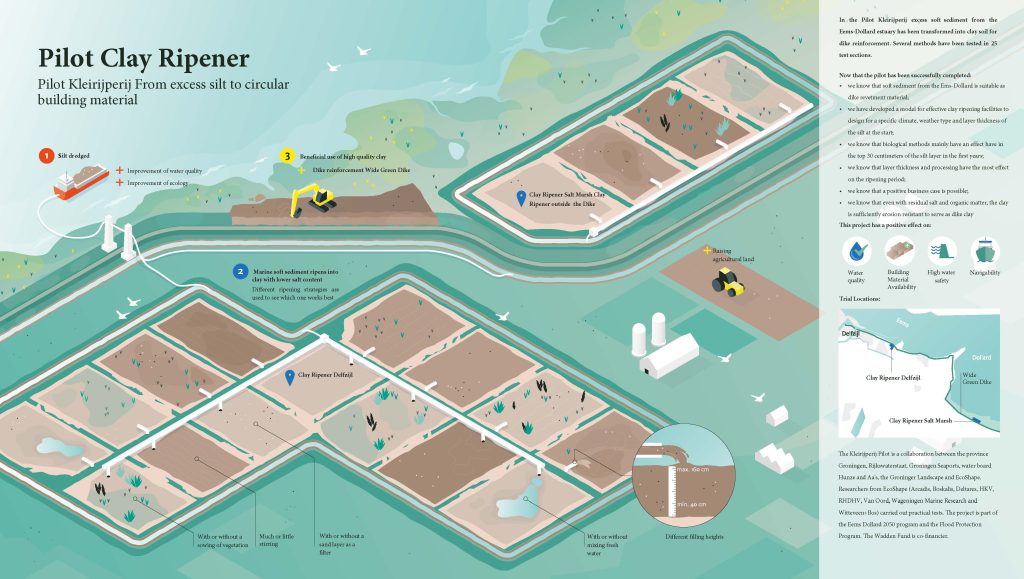In The Netherlands, near Delfzijl, the Clay Ripening Pilot was carried out. The results show that it is possible to turn saline dredge material from the Ems-Dollard into suitable dike clay through ripening. The reports provide information about suitable ripening methods and the business case for clay ripening.
For the pilot, two clay ripeners have been set up covering 24 hectares, divided in several test sections. The aim was to investigate innovative methods of clay ripening and to supply clay for an innovative dike strengthening pilot of 750 meters long, called test section of The Wide Green Dike.

Test Sections
The test sections of the clay ripener varied in:
• Application height (layer thickness)
• Number of filling moments to get the desired height
• Sowing with vegetation
• Presence of a draining sublayer
• Sweetening the salty clay with fresh water from the environment
• More and less tilling (plowing) of the clay soil
Guideline
For the application of clay in dikes in The Netherlands, the technical guideline ‘Clay for Dikes’ is generally used. Desired low levels of salinity and organic matter content as stated in this guideline, could not be met within the set timeframe at the Pilot Kleirijperij. Nevertheless, the clay has been successfully applied in the first 750 meters of the Brede Groene Dijk. This was possible by testing the erosion resistance and processability of the clay with a test dike on the salt marsh and with wave tests in the Delta Flume. These tests showed that the erosion resistance of the matured clay was good.
Results
Layer thickness appears to be the most important factor for the ripening process. Letting several thin layers ripen quickly worked better than letting one thicker layer ripen longer. Plowing the clay also ensures faster ripening. The number of filling moments had no significant effect on the ripening process. Sowing vegetation was not really necessary if plant seeds were present in the area. The presence of vegetation had an effect on the top 30 cm of the soil, but was not decisive for the ripening sections with greater depth.
Model for future clay ripening facilites
Based on the results, the researchers developed a mathematical model for the design of future clay ripening plants. This model provides insight into the ripening period and factors that influence it. The model is not only applicable for design, but also shows the effects of wet or dry summers. Furthermore, the model provides insight into the effects of climate scenarios on different ripening strategies.
Business Case
A business case has been made for the future clay ripeners. The largest costs are transport costs, land costs and construction costs. In addition, good coordination between supply and demand is important to prevent or limit storage costs. From a business perspective, a clay ripener with a long lifespan, close to the application location, aimed at high-quality use of the clay at a high price in the region is the most favorable.
Partners
The Clay Ripening Pilot is a collaboration between the province of Groningen, Rijkswaterstaat, Groningen Seaports, Hunze and Aa’s water board, the Groninger Landschap and EcoShape. Researchers from EcoShape (Arcadis, Boskalis, Deltares, HKV, RHDHV, Van Oord, Wageningen Marine Research and Witteveen+Bos) carried out the practical research. The project is part of the Eems Dollard 2050 program and the Dutch Flood Protection Program. The Wadden Fund is co-financier.

